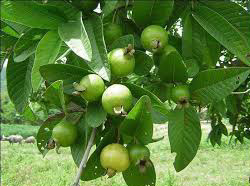Crop Production
Guava (Psidium guajava): Guava is one of the important fruit crops grown throughout the tropical and sub-tropical parts of India due to its a hardy nature and wider adaptability. It is considered as one of the exquisite, nutritionally valuable and a remunerative crop among the various fruit crops. Besides its high nutritive value, it produce good yield and economic returns involving very little inputs and little care and is good for rainfed areas.
Crop regulation
-
 Crop
regulation: In guava, two distinct
seasons of flowering viz., spring (April-May) and
rainy season (August-September) occur from which fruits
ripen respectively during rainy and winter seasons. In
South India a third flowering, although sparse, also
occurs during October. The rainy season crop of guava is
of poor fruit quality and is affected by many insect
pests compared to winter crop. Therefore regulation of
flowering is required to improve the fruit quality and
profitability by methods like withholding irrigation,
root exposure, pruning and thinning of flowers. In
different regions different methods of crop regulation
are followed depending on climatic factors, cropping
pattern etc. Withholding irrigation from December to
June or until the beginning of monsoon depending upon
prevailing conditions at a particular location has been
recommended in peninsular India. Practices like root
exposure and root pruning are practiced to suppress the
rainy season crop so as to get a good winter crop under
West Indian conditions. Pruning 3/4th and
half of current season’s shoot growth of spring flush
during 1st week of May to avoid rainy season
crop have been advocated in northern parts of the
country. Flower and fruit thinning manually and by
sprays of chemicals like napthalene acetic acid (NAA),
at 100-800 ppm depending on climatic condition,
napthalene acetamide at 50-75 pm, carbaryl at 300 ppm,
ethephon 300-500 ppm, 2-4 dichlorophenoxy acetic acid
(2,4-D) 30-50ppm and urea 10-15 percent were also found
effective under North Indian conditions. Under Bangalore
conditions, crop regulation by various methods such as
pruning, NAA, ethephon, potassium iodide and urea at
different concentrations did not yield desired results
for crop regulation.
Crop
regulation: In guava, two distinct
seasons of flowering viz., spring (April-May) and
rainy season (August-September) occur from which fruits
ripen respectively during rainy and winter seasons. In
South India a third flowering, although sparse, also
occurs during October. The rainy season crop of guava is
of poor fruit quality and is affected by many insect
pests compared to winter crop. Therefore regulation of
flowering is required to improve the fruit quality and
profitability by methods like withholding irrigation,
root exposure, pruning and thinning of flowers. In
different regions different methods of crop regulation
are followed depending on climatic factors, cropping
pattern etc. Withholding irrigation from December to
June or until the beginning of monsoon depending upon
prevailing conditions at a particular location has been
recommended in peninsular India. Practices like root
exposure and root pruning are practiced to suppress the
rainy season crop so as to get a good winter crop under
West Indian conditions. Pruning 3/4th and
half of current season’s shoot growth of spring flush
during 1st week of May to avoid rainy season
crop have been advocated in northern parts of the
country. Flower and fruit thinning manually and by
sprays of chemicals like napthalene acetic acid (NAA),
at 100-800 ppm depending on climatic condition,
napthalene acetamide at 50-75 pm, carbaryl at 300 ppm,
ethephon 300-500 ppm, 2-4 dichlorophenoxy acetic acid
(2,4-D) 30-50ppm and urea 10-15 percent were also found
effective under North Indian conditions. Under Bangalore
conditions, crop regulation by various methods such as
pruning, NAA, ethephon, potassium iodide and urea at
different concentrations did not yield desired results
for crop regulation.

